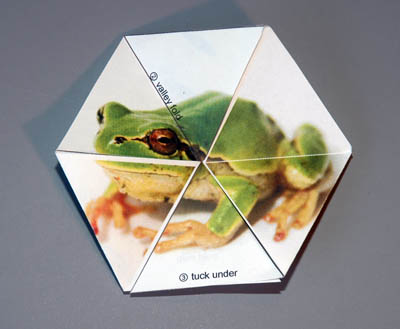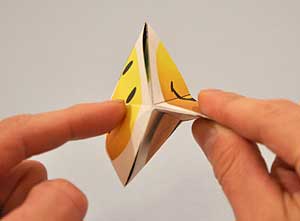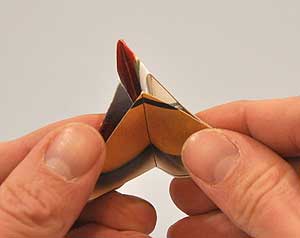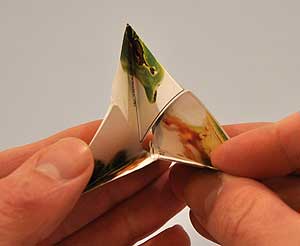Trihexaflexagon

Fold a strip of paper and glue the ends together to create a flexagon that displays different images as you turn it "inside out." This, the simplest of the flexagons, is called a trihexaflexagon because it displays three different images in a hexagon. There are a variety of flexagons with different shapes and number of images.
Steps
- Print the pattern double-sided and cut out the pattern piece.
- Follow the folding directions printed on the strip: first make a mountain fold where marked, then a valley fold. In the third step, "tuck under," switch positions of the two overlapping triangles; i.e. place the triangle labeled "tuck under" below the other triangle. Finally, fold the protruding triangle over and glue the two faces labeled "glue here" together.
 To use the flexagon, pinch two adjacent triangular faces together and push the opposite edge in.
To use the flexagon, pinch two adjacent triangular faces together and push the opposite edge in. With the flexagon pinched together, you can open the flexagon to reveal a new image. If you cannot open the flexagon at this point, repeat the previous step, but pinch two different triangular faces together.
With the flexagon pinched together, you can open the flexagon to reveal a new image. If you cannot open the flexagon at this point, repeat the previous step, but pinch two different triangular faces together. Repeat steps 3 and 4 until all images are revealed.
Repeat steps 3 and 4 until all images are revealed.
Notes
-
Flexagons were discovered by Arthur H. Stone in 1939 when he was a 23 year old graduate student at Princeton University. He trimmed his American-sized paper to fit in his British-sized notebook. He folded the resulting strips of paper and discovered the trihexaflexagon.
Links
- Scott Sherman's site has many exotic types of flexagons including flexagon puzzles.
Comments
comments powered by Disqus
